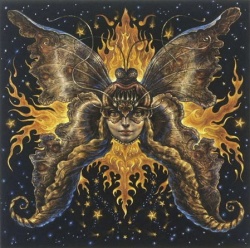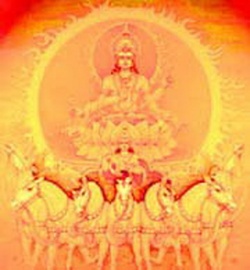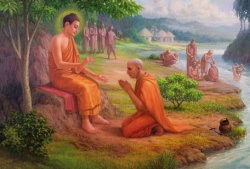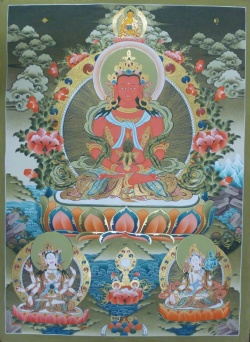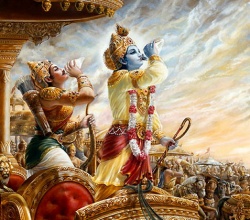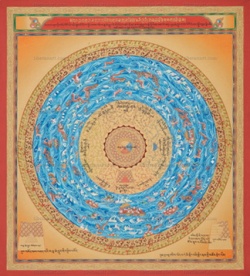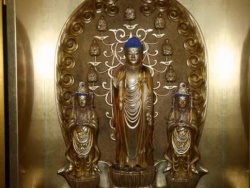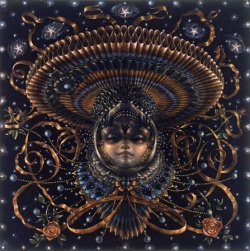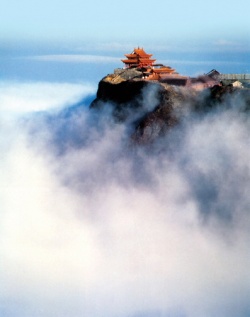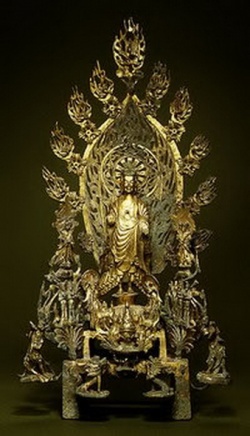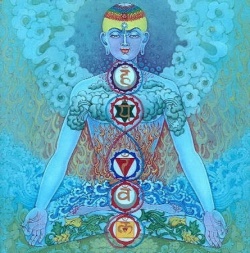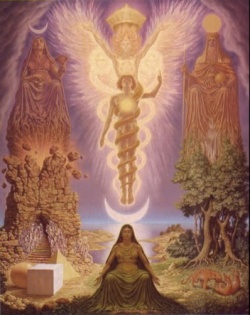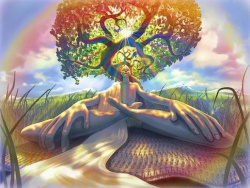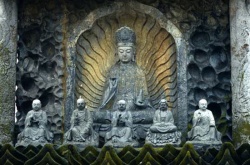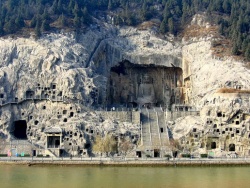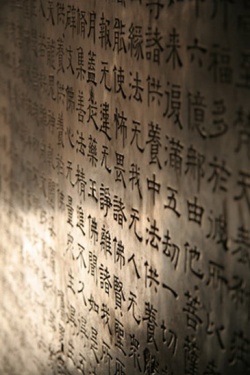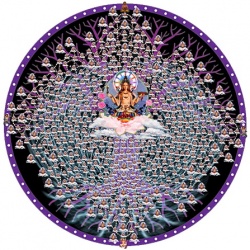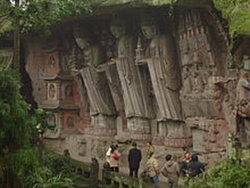Buddhist Cosmology II
Cosmology has come to play a central role in shaping what is now known as physical cosmology by bringing together observations and mathematical tools in order to analyze the universe as a whole: in other words, it is the understanding of the universe through scientific observation and experiment.
Cosmology is focused on the universe, as it exists on the largest scale and at the earliest moment, and it is generally understood to begin with the BIG BANG – an expansion of space from which the Universe itself is thought to have emerged from 13.7 billion years ago. From its violent beginnings, until its various speculative ends, cosmologists propose that the history of the Universe has been governed entirely by physical laws. Between the domains of religion and science, stands the philosophical perspective of metaphysical cosmology.
This ancient field of study seeks to draw intuitive conclusions about the origin of the universe, man, gods, and their relationships. Cosmology is one of the most important aspects of religion because it seeks to explain the existence and nature of reality. Viewing the creation and destruction of the universe will play a central role in the understanding of humanity’s role within the university. Questions about the earth’s origination have been discussed throughout history. Aristotle said the earth was the center of the universe through his experiments. He said the earth exists unchanged throughout eternity.
This belief was held strongly as a religious philosophy for more than 2000 years. In 1543 AD, Nicolaus Copernicus, an astronomer, published his theory on heliocentric cosmology, debunking the ancient believe that began the revolution of astronomy. But many astronomers still doubted his theory on cosmic origination. There, the questions remain: “What is the origin of the Universe?” “What is its first cause?” “Is its existence necessary?” Or, “What is the ultimate reason for the existence of the Universe?” In the Buddhist Sutta (the scriptures containing the Buddhist sermons), a consistent Buddhist cosmology is presented with the final analysis and reconciliation of cosmological comments. In several suttas, the Lord Buddha described other worlds and states of being, and one sutta described the origin and destruction of the universe: Agganna Sutta, Dhiga Nikaya.
This sutta was presented as a formal treatment by two novices, Bharadvaja and Vasettha. Therefore, according to the oldest record of study, the synthesis of this data for a single comprehensive system must have started from te history of Buddhism. Buddhist cosmology is the only religion that can explain the structure of the universe and tell you how all beings have relations with its existence. Being proficient in the study of cosmology will tell us why we are born and how to develop ourselves into a better life. The picture of the world presented in Buddhist cosmological descriptions cannot be described literally, with a literal description, or by any scientific experiment. This picture may be inconsistent with astronomical data that has been used up to the present day.
However, it can be perceived by everyone through the means of meditation: the entire universe has been seen through the Dibbayacakkhu (the divine eyes) by the Lord Buddha and people who have trained the mind enough to perceive the existence of all worlds and their interrelatedness. Buddhist cosmology can be divided into two related groups: temporal cosmology, which describes how the worlds come into existence, and how they pass away; and spatial cosmology, which describes the arrangement of the various worlds within the universe. Temporal cosmology Buddhist temporal cosmology describes how the university comes into being and, consequently, is dissolved. The basic unit of time measurement is the mahakappa or “Great Bear”.
The exact length of this time in human years is never exactly defined, but it is meant to be very long. The Lord Buddha compared the length of time of a kappa as a cubic hole in which 16 kilometers on each side is filled by cabbage seeds. One seed is thrown in the empty hole, and the next is thrown one hundred years later. The total time from the first seed being thrown until the last seed is thrown in order to fill a 16 kilometers cubic hole is equal to the length of time in one mahakappa.
A mahakappa (as described in Agganna Sutta) is divided into four parts or “minor eons”, each distinguished from the others by the stage of evolution of the universe during that kappa. The four minor parts of kappa are: • Samvattakappa “Eon of Dissolution” – during this kappa the universe dissolves. • Samvattathayikappa “Eon of Dissolution‐Duration” – during this kappa the universe remains in a state of emptiness. • Vivattakappa “Eon of Evolution” – during this kappa the universe comes into existence. • Vivattathayikappa “Eon of Evolution‐Duration” – during this kappa the universe remains in existence in a steady state. Each one of these minor eons is divided into sixty‐four antarakappas, so one mahakappa is equated to four minor kappas, and, therefore, four minor kappas are equal to two hundred and fifty‐six antarakappas.
The length of one antarakappa will be discussed later. This world is a cycle of existence and destruction. From the end time of the world, to viattathayikappa, the world is destroyed by three means: water, fire and wind, after which the chamber of the universe is empty. 1.1 Samvattakappa The samvattakappa begins when beings cease to be born in Naraka (hell). The devastation starts from the lowest realm of Aveci Naraka (the eighth lowest realm). The destruction by fire is the first type that occurs at the end of the samvattakappa. After destructions by fire, there is destruction by water. This is more devastating, because it eliminates all that is left of the Brahma Abhassara worlds and any other higher worlds.
This devastation proceeds in reverse order to the vertical cosmology; i.e., Pettas, then Animals, then Humans, and so on up through the realms of the deities (The origin each realm noted in italics will be discussed later). When these worlds (except the Brahman worlds) are devoid of inhabitants, a great fire consumes the entire physical structure of the worlds. It turns all the worlds below the Abhassara worlds. When they are destroyed, the Samvattathayikappa begins. As mentioned, the length of time of the first minor kappa contains sixty‐four anatarakappas. 1.2 Samvattathayikappa There is nothing to say about the samvattathayikappa because nothing happens in it below the Abhassara worlds.
It ends when the primordial wind begins to blow and build the structure of the worlds again. As mentioned, this period contains sixty‐four antarakappas, equal to the Samvattakappa. 1.3 Vivattakappa The vivattakappa begins with the arising of the primordial wind, which begins the process of building the structures of the universe that had been destroyed at the end of the mahakappa. Because the extent of the destruction can vary, the nature of this evolution can vary as well, but it always takes the form of beings from a higher world being born into a lower world.
The example of a Mahabrahma being the rebirth of a deceased Abhassara brahma is just one instance of this, which continues throughout the vivattakappa until all the worlds are filled from the Brahmaloka down to Naraka. During the Vivattakappa, the wind blows the chamber of the universe to cool it down and the elements compose themselves as water. Solid composites float on the water. Then, land appears as the floating solid above the water.
The first humans appear here although they are not like present day humans, but are beings shining in their own light. In fact, they are beings from the Abassara Brahma world, capable of moving through the air without mechanical aid, living for a long time, and not requiring sustenance. They are more like a type of lower deity than they are like present day humans. Over time, they acquire a taste for physical nutriment, and as they consume it, their bodies become heavier and more like human bodies: they lose their ability to shine, begin to acquire differences in their appearance, and they experience a decrease in their life span.
At this point, and in order to light this new plane of existence, the sun comes into being. Humans are then differentiated into two sexes, depending on the past life’s retribution. For example, a being who had committed adultery in their past life will become a female, and will begin to become sexually active. With this sexual activity comes passion and with passion comes the need to hide their sexual activity. This creates the need for individual housing.
Then, greed, theft, and violence arise among them, and they establish social distinctions. When this happens, a government is formed and they elect a king in order to rule them. This person is called a Mahacakavatti, or, the Great Appointed One. Since becoming human, the divine bodies turn more crude, or base. Some of them begin to hunt and eat the flesh of animals, which have by now come into existence. These developments are also described in the Agganna Sutta. The third minor kappa also contains sixty‐four antarakappas. 1.4 Vivattasthayikappa The Vivattasthayikappa begins when the first being dies and is born into Naraka, thus filling the entire universe with beings. During the first antarakappa of this fourth eon, human lives are declining from a vast but unspecified number of years toward the modern lifespan of less than ten years. From the divine state, their life span is an asonkaiya of years; one asonkaiya is approximately 1x10140 years. The life span of humans decreases because of the wicked deeds they perform. Every one hundred years, their life span will decrease by one year.
The asonkaiya years will lose one year every hundred years until their life span averages a total of ten years. At the point, when their life span is at the lowest point, or least number of years, they must realize that they need to do good deeds in order to cultivate merit. When they do realize this, their life span will increase one year every one hundred years until it reaches the maximum of asonkaiya years. The length of time (or one cycle) from one asonkaiya to the tenth, and reverse, is called one antarakappa. At the beginning of the antarakappa, people are still generally happy.
They live under the rule of a universal monarch, or “wheel‐turning king” (Mahacakkavatti), who conquers. The Mahasudassan Sutta, Dhiga Nikaya Mahavakka (the longest Buddhist scripture), tells the life of a cakkavatti king, Mahasudassana (Sanskrit: Mahasudarsana) who lived for countless years. As a result of human beings subsequent misrule, poverty increases; as a result of poverty, theft begins; as a result of theft, capital punishment is instituted; and, as a result of this contempt for life, murders and other crimes become rampant. As the human lifespan gradually decreased from 1x10 140 to 100 years, each generation increases other crimes and evil misdoings: lying, adultery, evil speech, greed, hatred, wrong views, incest, and other sorts of sexual abnormalities, and disrespect for parents and elders. The realms generate themselves in order to support the dead. Everyone who performs good deeds throughout their lives is supported by heavenly realms.
And, vice versa, the ones who perform bad deeds are supported by hell. In other words, the consequence of a person’s deeds come to fruition in subsequent realms. People will reappear in the lower or higher realms according to the previous life’s kamma or the fruits of their actions. During this period, the pettas, surakaya, animals, humans, deities, and Brahmas occur in this world. Because the beings in this world suffer, many humans try to escape. The ones who try to escape from the cycle of living, Samsara, are called Bodhisattvas or people who aim toward enlightenment.
In the Mahapadana Sutta, three of the four Buddhas of this fourth minor kappa lived: Kakusandha Buddha, at the time when the average lifespan of humans was 100,000 years; Konagamana Buddha, when the average lifespan of humans was 80,000 years; and Kassapa Buddha, when the average lifespan of humans was 20,000 years. Our present time is thought to be a part of the end of the second last antarakappa of this Vivattasthayikappa, when the average lifespan is approximately 100 years.
This is the age of the Sakyamuni Buddha or Gotama Buddha, who lived to the age of 80. After the Gotama Buddha’s nirvana, the remainder of the fourth kappa is prophesied to be miserable: lifespans will continue to decrease, and all the evil tendencies of the past will reach their ultimate in destructiveness.
The world will lead to the end of an antarakappa again. People will live no longer than ten years, and will marry at five; foods will be poor and tasteless; no form of morality will be acknowledged. The most contemptuous and hateful people will become rulers. Incest will be rampant. Hatred among people, even members of the same family, will grow until people think of one another as hunters do to their prey. Eventually, a great war will ensue, in which the most hostile and aggressive beings will arm themselves and go out to kill one another. The less aggressive will hide in forests and other secret places while the war rages.
At the end of the war, the survivors will emerge from their hiding places and, seeing what evil deeds they have done in the past, repent. As they begin to do good deeds, their lifespan increases, and the health and welfare of the human race will increase with it. After a long time, the descendants of those with a ten‐year lifespan will gradually increase until it reaches the maximum asonkaiya years. Then it will gradually decrease again until it hits the average of 80,000 years, and at that time, there will be a cakkavatti king names Sankha. During his reign, the current bodhisattva in the Tusita heaven will descend and be reborn under the great family of Brahma. He will enter the life of an ascetic and will gain perfect enlightenment as a Buddha.
He will then become known by the name of Metteyya, the last Buddha of this Mahakappa. After Maitreya’s time, the world will again become worse, and the lifespan will gradually decrease from 80,000 years to 10 years, each antarakappa being separated from the next by devastating wars but with peaks of high civilization even though morality will be at the minimum. After the end of the 256th antarakappa, the lifespan will no longer increase because the Vivattasthayikappa will have come to an end. It will then enter the Samvattakappa again. 2. Spatial Cosmology Spatial Cosmology can also be divided into two branches.
Vertical cosmology describes the arrangement of worlds in a vertical pattern, some being higher and some lower. In contrast, horizontal cosmology describes the grouping of these vertical worlds. 2.1 Vertical Cosmology In vertical cosmology, the universe consists of many worlds (lokah), or planes, stacked one upon the next in layers. Each world corresponds to a mental state or state of being. A world in Buddhism is not so much a location as it is the beings that compose it; it is sustained by their karma and if the beings in a world all die or disappear, the world disappears, too.
Likewise, a world comes into existence when the first being is born into it. The physical difference or separation, is not as important as the difference in mental state; humans and animals, though they partially share the same physical environments, still belong to different worlds because their minds perceive and react to those environments differently. Vertical cosmology is divided into thirty‐one planes, thirty one realms or thirty one bumis, each corresponding to a different type of mentality. All thirty one can be divided into three categories (Tridhatu): the Arupadhatu (Arupabumi), the Rupadhatu (Rupabumi) and the Kamadhatu (Kamabumi). In the latter scheme, all of the beings born in the Arupadhatu and the Rupadhatu may be classified as “gods” or “deities” (devah), as can a considerable fraction of the beings born in the Kamadhatu, even though the deities of the Kamadhatu differ more from those of the Arupyadhatu than they do from humans.
It should be understood that deva is an imprecise term referring to any being living in a longer‐lived and generally more blissful state than humans. However, all of them are not “gods” in the common sense of the term, but they are involved with good deeds when they are humans. The fruits of different levels or amounts of good deeds allowed them to be born in a higher and happier realm. But when the fruit of those deeds have run out, they will be reincarnated as humans, or lower beings, according to the inner fruits of their deeds. The term “brahma” is used both as a name and as a generic term for one of the higher devas. In its broadest sense, it can refer to any of the inhabitants of the Arupadhatu and the Rupadhatu. In more restricted senses, it can refer to an inhabitant of one of the nine lower worlds of the Rupadhatu, or in its narrowest sense, to the three lowest worlds of the Rupadhatu.
A large number of devas use the name “Brahma”, e.g. Braham Sahampati, Brahma Sanatkumara, Baka Brahma, etc. This is also discussed further in the Buddha’s biography. 2.1.1 Arupadhatu The Arupadhatu, or “Formless Brahma realm”, belongs to those devas who attained and remained in the Four Formless Absorptions (catuh‐samapatti) of the arupajhana or the level of formless tranquil meditation in a previous life. Those who are in this realm consume the feeling of happiness in arupajhana samapatti as nutrition and enjoy the fruits (vipakka) of the good karma of that accomplishment. Niyatabodhisattvas, the Bodhisattvas whose destiny it is to be future Buddhas, are never born in the Arupadhatu even when they have attained the arupajhana.
There are four worlds or realms of the Arupadhatu Brahmas, corresponding to the four types of arupajhana that range from the depth of Jhana. • Nevasannanasannayatana “Sphere of neither perception nor non‐perception”. In this sphere the formless beings have attained a luminal state or the fourth formless absorption of meditation. For example: This was the sphere reached by Uddaka Ramaputta, the second of Prince Siddhattha’s two teachers, who wrongly considered it equivalent to enlightenment. The average age of beings in this sphere is approximately 84,000 Mahakappas. • Akincannayatana “Sphere of Nothingness” (literally “lacking anything”).
In this sphere, formless beings dwell contemplating upon the thought that “there is no thing” or the state of third formless absorption meditation. For example: This was the sphere reached by Alara Kalama, the first of Prince Siddhattha’s two teachers, who wrongly considered it to be equivalent to enlightenment. The average age of beings in this sphere is approximately 60,000 Mahakappas. • Vinnanancayatana “Sphere of Infinite Consciousness”. In this sphere, formless beings swell meditating on their consciousness as infinitely pervasive, or the state of second formless absorption meditation. The average age of beings in this sphere is approximately 40,000 Mahakappas.
• Akasanancayatana “Sphere of Infinite Space”. In this sphere, formless beings dwell meditating upon space, or extensions, as infinitely pervasive. This is the state of the first formless absorption meditation. The average age of beings in this sphere is approximately 20,000 Mahakappas. 2.1.2 Rupadhatu The Rupadhatu, or Form Realm, is, as the name implies, the first of the physical realms: All of the inhabitants of this realm are located within this realm in some type of physical body. The beings in the Form realm are not subjected to the extremes of pleasure and pain, nor are they governed by desires for things pleasing to the senses, as are the beings of the Kamadhatu.
The bodies of the Form realm beings do not have sexual distinctions but, instead, look androgynous. Like the beings of the Arupadhatu, the dwellers in the Rupadhatu have minds corresponding to the rupajhanas, the tranquility form of meditation. However, the beings of the Rupadhatu can be divided into eleven grades, corresponding to the four levels of rupajhana, plus five “Pure Abodes” corresponding to the Suddhavasa Brahma beings who attained the third stream enterer (Anagami) in their previous lives. 2.1.2.1
The Worlds of Suddhavasa (Five Pure Abodes) There are five levels of attainment in the worlds of Suddhavasa categorized by purity in the following five faculties: faith (saddha), effort (viriya), mindfulness (sati), concentration (Samadhi), and wisdom (panna). • Akanittha: The realm of the Supreme Brahmas: These are Brahmas in whom wisdom is the strongest of faculties. Akanittha Brahmas are endowed with the greatest heavenly wealth and happiness.
Brahmas in the four other realms of the Pure Abodes are able to move into upper realms, but Supreme Brahmas are born and die in their own realm. An important sanctuary is located within the Realm of Supreme Brahmas named Dussa‐ Cetiya. Kept in this monument are the royal robes of Prince Siddhattha that he wore the day that he renounced his kingship and was ordained as a Buddhist monk. Ghatikaara Brahma came down from the Supreme Brahma realm to offer the eight requisites to the ordaining prince. He kept the robes together with one of the requisites, in the Dussa‐Cetiya, which is about 192 kilometers (twelve leagues (yojana) in height.)
The average age of beings in this sphere is approximately 16,000 Mahakappas. • Sudassii: The Realm of Brahmas Who Are Clear‐Sighted: These are Brahmas in whom concentration is the strongest of faculties. They can see even more clearly than Beautiful Brahamas especially through their two physical eyes: Divine Eye and Wisdom Eye. The average age of beings in this sphere is approximately 8,000 Mahakappas. • Sudassaa: The Realm of Beautiful Brahmas: These are Brahmas in whom mindfulness is the strongest of faculties. They therefore have the Five Eyes of the Blessed One; The physical eye which is exceptionally powerful and sensitive, the Divine Eye, the Wisdom Eye, the Buddha Eye and the All‐seeing Eye. They are endowed with great beauty.
They are endowed ith great beautiful – a pleasure for all others to look upon. The average age of beings in this sphere is approximately 4,000 Mahakappas. • Atappaa: The Realm of Serene Brahmas: These are Brahmas in whom perseverance is the strongest of faculties. They never fall from happiness because their mind is immersed in meditation the whole time. They are free from all mental hindrances. The average age of beings in this sphere is approximately 2,000 Mahakappas.
• Avihaa: The Realm of Brahmas Who Do Not Fall from Prosperity: These are Brahmas in whom faith is the strongest of faculties. They will not be reborn before reaching their allotted span. Brahmas in the four higher realms, however, can choose to be born before reaching their allotted span. The average age of beings in this sphere is approximately 1,000 Mahakappas. 2.1.2.2 The Eleven Realms of the Fourth Absorption (Catuthajhana) The other absorption spheres are inhabited by those who have attined the four levels of Absorption, including eleven spheres ranking from the deepest of the absorption spheres to the less deep absorption spheres.
• Asanniisattaa: The Realm of Non‐Percipient Beings: These beings are endowed with no sensation (vedanaa), perception (sannaa), mental formations (sankhaara) or consciousness (vinnaana). They are only endowed with the aggregate of corporeality with the a bility to put out all feelings – but they still have defilements. They have a golden form similar to a Buddha image, and can take anyone of the three postures: sitting, lying, or standing, depending on the position they died in, in their previous life. They will remain in such a position throughout their lives. The realms in the fourth absorption sphere are located higher than the third absorption sphere. Brahmas in the higher realms can see those in the lower realms, but those in the lower realms cannot see those in the higher ones.
Form‐Brahmas in the eleven realms mentioned so far will all return to be reborn in hell or heaven, depending on their past karma, for as long as they have not attained the stages of sainthood. The average of beings in this sphere is approximately 500 Mahakappas. • Vehapphalaa: The Realm of Brahma with Abundant Rewards: The power of merit there is exempt from destruction and dissolution. Among those Brahmas in the nine levels mentioned so far, those in the realm of Brahmas with steady aura live the longest lives or sixty‐four world cycles. Anyone who reaches sixty‐four world cycles will return to be reborn during the re‐evolving of the world system. These Brahmas are followed by other Brahmas with shorter lives.
After sixty‐four world cycles, the third absorption sphere will be destroyed by wind. However, the Realm of Brahmas with abundant rewards is resistant to destruction by fire, water or world‐cycles winds. Brahmas in Vehapphala therefore live for 250 Mahakappas. • Subhakinha: The Realm of Brahmas with Steady Aura. The average age of beings in this sphere is approximately 64 Mahakappas. • Appamanasubha: The Realm of the Brahmas of Infinite Luster. The average age of beings in this sphere is approximately 32 Mahakappas. • Parittabhaa: The Real;m of the Brahmas of Limited Luster. The average age of beings in this sphere is approximately 16 Mahakappas. • Aabhasara: The Realm of Brahmas with Radiant Luster Beings are reborn here as a result of their bright and clear mind.
The average age of beings in this sphere is approximately 8 Mahakappas. • Appamanabha: The Realm of Brahmas with Infinite Aura. The average age of beings in this sphere is approximately 4 Mahakappas. • Parittabha: The Realm of Brahmas with Limited Aura: These besings have an aura as that of the moon, however, less brilliant than that of Brahmas in higher realms. The average age of beings in this sphere is approximately 2 Mahakappas. • Mahabrahma: The Realm of the Great Brahmas: These inhabitants are Brahmas who have attained the highest level of first absorption. They are the leaders of the first two types of Brahmas. Sahampati Brahma, who originally invited the Lord Buddha to share his message with teachable beings, was also an inhabitant of this realm. Brahmas who have attained the highest level of first absorption will be at the center of each realm and surrounded by those who have attained lower levels of Absorption.
The average age of beings in this sphere is approximately 1 Vivattasthayikappa. • Brahmapurohita: The Realm of the Great Brahmas’ Ministers: The inhabitants are Brahmas who have attained the medium level of first absorption. They help the Great Brahmas with various tasks. Inhabitants of this realm are those who have attained the first absorption. The following three levels of this first absorption realm are located on the same level as one anoter, rather than being one above the other as in the heaven realms. The average age of beings in this sphere is approximately ½ Vivattasthayikappa. • Brahmapaarisajja: The Realm of the Great Brahmas’ Attendants: The inhabitants are brahmas who have attained the beginning level of first‐absorption.
They are ordinary Brahmas with no extraordinary power. They are followers of the Great Brahmas. The average age of beings in this sphere is approximately 1/3 Vivattasthayikappa. 2.1.3 Kamadhatu The worlds of Kamadhatu are 1,344.000 yajanas (21,504,000 kilometers) below the Brahmapaarisajja world. The beings born in the Kamadhatu differ in degree of happiness, but they are all, other than Arahats and Buddhas, under the domination of Maras (Evils) and are bound by sensual desire, which causes them suffering.
All devas in these realms reappear after death in human form because of the fruits of their good deeds – such as giving (dana), sila (precepts) and bhavana (meditation) – since they were born as human. All six levels of these realms are aligned vertically above the Mount of Sumeru (the center mountain of the universes). 2.1.3.1 The Six Levels of Heaven Realm The following four levels are bounded planes. Each level is separated by air, about 84,000 yojanas (1.344.000 kilometers) thick, and floats in the air above the top of Mount Sumeru.
Although all of the worlds inhabited by devas (that is, all the worlds down to the Caturmaharajikakayika world and sometimes including the Asuras) are sometimes called “heavens” and in the western sense of the word, the term best applies to the four worlds listed below: • Paranimmitta‐vasavatti: The heaven of devas “with power over [others] creations”. The name of this level comes from the two rulers of this realm: the “Paranimitta King” (the right thought one) and “Vasavatti”(the wrong thought one) who have longer life spans, greater beauty, more power, more happiness, and more delightful sense‐objects than the other devas of this world.
These devas do not create pleasing forms that they desire for themselves, but their desires are fulfilled by the acts of other devas who wish for their favor. The ruling areas of this world are divided into two parts: one for homes of the right thoughts (Vimaras), and the other for homes of the wrong thoughts (beings of the evil divine race called Devaputta Mara and their homes are called Vasavatti). One full day in this world is equated to 1.600 years of human time. The beings of this world live for 9,216,000,000 years. • Nimmanarati: The world of devas “delighting in their creations”. The devas of this world are capable of changing their appearance in order to please themselves. The lord of this world is called Sunimmita. The beings of this world live for 2,304,000,000 years. Visakah Mahaupasika, the foremost female donator and the first stream enterer, who also reappears in this realm as the Queen of Sunimmita. • Tusita: The world of the “joyful” devas.
This world is best known for being the world in which a Bodhisattva lives before being reborn into the world of humans. Until a few thousand years ago, the ruler of this world was Santatusita King, who was reborn as Siddhattha and became the Lord Buddha Gotama. Now the Bodhisattva has been Natha who will be reborn as Ajita and will become the Buddha Metteyya. While this Bodhisattva is the foremost of the dwellers in Tusita, the ruler of this world is another deva called Santusita. The world has divided into four parts from inside to outside as follows: 1.
The area for the Ruler and devas who are first and second stream enterers (Sotapanna and Sakidagami). The millionaire, Anathapindika, who was the foremost male donator to the Lord Buddha Gotama, reappears in this area. The Lord Buddha’s mother, Queen Maya, also reappears as a male deva in this zone. 2. The area for Niyatabhodhisattvas, the certain future Buddha zone. This area is the zone of the Bodhisattva who has been predicted by the previous Buddhas who will become enlightened as one of the future Buddhas.
The special merit zone of Luang Pu Wat Paknam and his followers are also in this zone. 3. The area for Aniyatabhodhisattvas, the uncertain future Buddhas zone. This area is the zone of the Bodhisattva who has not been predicted by the previous Buddhas that will enlighten as one of the future Buddhas but is still cultivating perfections in order to become one of the future Buddhas. 4. The area for normal good deed doers who accumulate merit and perfection enough to reappear in this world but who do not want to become future Buddhas.
The beings of this world live for 576,000,000 years • Yama: Sometimes called the “heaven without fighting” because it is the lowest of the heavens to be physically separated from the turmoil of the earthly world. These devas live in the air, free of all difficulties. Its ruler is the deva Suyama King. The beings of this world live for 144,000,000 years. This world, and the worlds above, lies over the shining of the sun: The day and night are recognized by the celestial flowers that bloom and close. Therefore, the light of this world are from the deva’s aura.
Worlds of Sumeru The world mountain of Sumeru is an immense, strangely shaped peak, which arises in the center of the universe, and around which the Sun and Moon revolve. Its base rests in a vast ocean, and it is surrounded by several rings of lesser mountain ranges and oceans. The three worlds listed below are all located on or around Sumeru: the Tavatimsa devas live on its peak, the Caturmaharajikaka devas live on its slopes, and the Asuras live at its base. Sumeru and its surrounding oceans and mountains are the home not just of these deities, but also vast assemblies of beings of popular mythology, who only rarely intrude on the human world. • Tavatimsa: This world is named for the thirty‐three deva rulers and is a wide flat space on the top of Mount Sumeru, filled with the gardens and palaces of the devas.
Its highest ruler is Sakka, Devaindra, or Magawan, meaning “minister of the devas”. This world has been divided into three phases which are then divided into thirty‐three zones. Each zone is named for a regional deva, although many other devas and supernatural beings dwell here. This is the world where the Lord Buddha spent three months (Vassa) in discourse with his mother. The beings of this world live for 36,000,000 years. • Catumaharajika: The world of “The Four great Kings” is found on the lower slopes of Mount Sumeru, although some of its inhabitants live in the air around the mountain. Its rulers are the four Great Kings: Virundhaka, Dhatarattha, Virapaksa, and Vesuvanna.
The devas who guide the Sun and the Moon are also considered to be a part of this world because they are the retinues of the four kings. They are composed of the following: Grudha, the phoenixes; Kandhabba, the musicians; Vidhayadara, the physicians; Nagas, the dragons; and, Yaksas, the ogres. The beings of this world are in the form of devas, but they are able to transform themselves into many non‐deva forms. They live here for 9,000,000 years. King Bimbhisara, the first donator of a Buddhist monastery and the first stream‐enterer, also reappears as a Yaksa in this realm.
In the scriptures, it is said that he could be in any level of Kamadhatu or Rupadhatu (except the Suddhavasa worlds) but he chose to live here because he likes the familiarity of this world. • Asura: The world of the Asuras is the plain under the foot of Mount Sumeru. It is not the Asura’s original home, but the place they found themselves after they were hurled, drunken, from Tavatimsa where they had formerly lived. The Asuras are always fighting to regain their lost kingdom on the top of Mount Sumeru, but they are unable to break the guard of the Four Great Kings. The Asuras are divided into many groups, and have a ruler called Vepacitti.
The average age is this world is almost equal to the Tavatimsa world. 2.1.3.2 Earthly Realms • Manusaloka: This is the world of humans and the human‐like beings who live on the surface of the earth. The mountain‐rings that encircle Sumeru are surrounded by four vast oceans that fill most of the world. In these oceans, there are four continents that are located on the four earths. Because of the vastness of the ocean, they cannot reach one another by ordinary sailing vessels. In the past, when the cakkavatti kings ruled, communication between the continents was possible by means of a treasure called the cakkaratana (the Crystal Wheel), which the cakkavatti and his retinue would use to fly through the air between the continents.
The four continents are: 1. Jambu Continent is located in the south of Sumeru and is the dwelling of ordinary human beings. It is said that on this continent, the shape of a human’s face is over which is the shape of faces in of faces in our own world. This world is where we are living, and the description probably echoes the shape of the coastline of southern India. The continent takes its name from a giant Jambu tree (Syzygium cumini), 100 yojanas tall, that grows in the middle core of the continent.
Every continent has one of these giant trees. All Buddhas and arahants appear only in Jambu continents. The people here are one to eighty feet tall and their lifespan varies between 100,000 and 10 years, depending on the mahakappa in which they are living. 2. Pubbavideha Continent is located in the east of Sumeru and it is said that the shape of the human’s face is like a semicircle. Its tree is the acacia. The people here are about 12 feet tall and they live for 250 years. 3. Aparagoyana Continent is located in the west of Sumeru and it is said that the shape of the human’s face is like a full moon or circle. The tree of this continent is a giant Kadamba tree. The human inhabitants of this continent do not live in houses, but sleep on the ground.
They are about 24 feet tall and they live for 500 years. 4. Uttarakuru Continent is located in the north of Sumeru and it is said that the shape of a human’s face is like a square. This continent’s tree is called a kapparukkha or kappa‐tree, because it lasts for the entire kappa. The inhabitants of Uttarakuru are said to be extraordinarily wealthy. They do not need to labor for a living, as their food grows by itself and they have not private property. They are about 48 feet tall and live for 1,000 years. 2.1.3.3 Unpleasant Realms The unpleasant realms of the universe of the existence are the abodes where beings suffer from pain and woe.
They beings are unable to perform any good deeds. These worlds consist of four realms: tiracchana (animals), petas or petaloka (hungry ghosts), asuurakaya (hungry monsters), and narakas (hells). 2.1.4.1 Tiracchana: This world comprises all members of the animal kingdom that are capable of feeling suffering, from the smallest (invisible to the naked eye) insects to the elephants. 2.1.4.2 Pretaloka or Petaloka: The petas, or “hungry ghosts”, are mostly dwellers on earth, though due to their mental state, they perceive it very differently from humans. The majority of petas are underneath the Mount of Sumeru where there are twelve species of them. Some of them are living in the human world although they are invisible to the naked eye except for Dhammacakkhu (the dhammakaya eyes). Most live in the desert and wastelands. 2.1.4.3 Asuurakaya: This world is the abode of unrelenting and dejected demons. All of them are starving and emaciated.
The major karma or sin that made them reappear in this realm is stealing monastic belongings or doing extremely bad deeds while in one of their previous human lives. 2.1.4.4 Naraka or Niraya: This is the name given to one of the worlds of the greatest suffering, usually translated into English as “hell” or “purgatory”. As with the other realms, a being is born into one of these worlds as a result of his karma, and resides there for a finite length of time until the results of his karma has been fulfilled, after which he will be reborn into one of the higher worlds as the result of an earlier karma that had not yet ripened. The mentality of a being in the hells corresponds to states of extreme fear and helpless anguish in humans. Physically, Naraka is thought of as a series of layers extending below the Mount of Sumeru. There are several schemes for counting these Narakas and enumerating their torments. One of the more common is that of the Hot Eight Major Narakas, one hundred and twenty‐eight satellite hells, and three hundred and twenty purgatories.
In total, there are four hundred and fifty‐six realms of “hot” hells and one “cold” hell, called Lokanta. These are explained in the following manner: Eight Major Hells: The Major Hell, comprising eight levels, is the largest region within the hell realms. Inside there are denizens of hell who are obligated to inflict punishment on those reborn in hell. These denizens arise spontaneously as a result of evil deeds done by their victims. The eight levels of Major Hell are as follows: • Sanjiva: This level is one in which beings are brutally punished according to their evil deeds done in the past.
They are punished in several ways, such as being cut into pieces or being burned to death. When they die, a so‐called “karmic wind” will blow and they will be born again. This cycle will repeat itself again and again until their karmic debt has been paid off. Killing is the main karma leading human beings to be born in this major hell. This level of Hell is also called the “reviving” Naraka and “life” here is 162*1010 years long. • Kalasutra: This level is known as the “black thread” Naraka because in this level the denizens of hell punish the victims by putting them on red hot steel plates which is marked off with black steel threads as big as a palm tree.
The victims are then put on the steel plates before cutting them into pieces along the black marks. Stealing is the main karma earning a place for beings in this major hell. Life in this Nataka is 1296*1010 years long. • Samghata: This is known as the “crushing” Naraka. The victims are roasted in agony in the fires of hell before being crushed to death between two steel mountains. Sexual misconduct is the main karma earning a place for beings in this major hell. Life in Samghata is 10,368*1010 years long. • Raurava: This level is known as the “screaming” Naraka. Beings are laid face down in a steel lotus. As soon as they are up to their cheeks at one end and up to their toes and wrists at the other end, flames of a fire reach up and incinerate the lotus with the victim inside.
Telling lies is the main karma earning a place for beings in this major hell. Life in Raurava is 82,944*1010 years long. • Maharaurava: This is the “great screaming” Naraka. Beings are forced to stand in a steel lotus which has hot, sharp, black petals. They are burned from head to tow, from the inside out, through their nine bodily openings. The fire is so hot that this level of hell is sometimes called “the hell that is filled with fire‐induced cries of pain”. Taking alcohol and drugs is the main karma earning a place for beings in this major hell. Life in this Naraka is 663,552*1010 years long. • Tapana: This is the “heating” Naraka. Victims are forced to climb up onto the point of a spear the size of a palm tree engulfed in flames.
They find themselves impaled on the point of the spear and are burned like a chicken on a spit before being eaten by an enormous dog that tears the flesh from their bones. Being addicted to gambling is the main karma earning a place for beings in this major hell. Life in this Naraka is 5.308,416*1010 years long. • Mahatapana: This is the “great heating” Naraka. Beings are stabbed with swords and spears engulfed in flame as they are chased up a volcano before the acid rain blows down on them, while from below they are pierced by gigantic steel thorns. A life involved with the roads to ruin [apayamulkha] is the main karma earning a place for beings in this major hell. Life in this Naraka is 42,467,328*1010 years long. • Avici: This level is the “uninterrupted” Naraka. In some of the hells, there are times when the torment is more, and there are times when the torment is less. In this hell, the torment is continuous.
It is the biggest hell that is full of terrors and is also the most frightful. It is surrounded by burning steel gates. There are more beings here than in other hells. They are punished in the same posture that they committed their evil deeds. Killing their parents, killing or harming enlightened ones, harming a Buddha, or creating a schism in the monastic community are all the main reasons for beings to be subjected to this karma. Life in this Naraka is 339,738,624*1010 years long. Satellite [Ussada] Hells A satellite hell is a group of realms occupied by those who have already exhausted their retribution in the relevant major Hell. Around each level of major hells there are sixteen satellite hells (four in each of the compass directions). There, there are a total of 128 satellite hells.
Satellite hells are located in the equivalent direction of each major Hell and are referred to by the same name as that major Hell but differ in degree of severity. Purgatory (Yamaloka) Those human beings whose retribution has not been exhausted, come to this level of hell after traversing the satellite hells. Each major Hell has ten Purgatory realms around it, at each of the four compass points. There are a total of 320 units of Purgatory if all of the eight major Hells are counted. There is no real difference between the purgatories in the different directions or attached to different levels of each major hell except for the degree of severity. Inside the purgatory, a judge with his jury decides what realm beings should be sent to next. The judge and jury are angels, unlike the denizens of hell who arise spontaneously by force of the bad karma in each of the victims. 2.1.5 Cold Hell (Lokanta) This is the special level of hell where there is eternal darkness. The beings condemned in this level of hell have huge bodies. They cling on to the rim of the cosmos by their fingernails.
If they encounter fellow victims in this hell, they assume that they are one anothers food and attach each other mercilessly. Sometimes, they fall into an icy sea of acid which eats away at their body. Once out of the acid, they re‐affix themselves on the rim of the cosmos. They endure torment in this way for an undefined length of time. Only when a Buddha becomes enlightened, is there ever a brief flicker of brightness in the darkness there. Having extreme false view (false view so erroneous that they can even hurt monks) is the main karma earning a place for beings in this level of hell. 2.2 Horizontal cosmology and the foundations of the universe All of the structures of the earth, Sumeru and the rest are explained by the Lord Buddha. We need to understand that this world, though seeming to be boundless and consisting of innumerable things, is indeed only a small point in even this immense universe. If we combine all the universes together, we will find that even the cosmos can vary in size: large and small, depending on how many universes exist in each.
The Lord Buddha discovered the existence of not one, but countless universes more than 2,500 years ago. The Buddha’s discovery of 2,500 years ago conforms to scientific discoveries made only in the last few decades. It is, therefore, amazing how the Lord Buddha could discover such fact so accurately 2,500 years ago when scientific knowledge had not discovered these facts. The Lord Buddha’s observation about the universe is recorded in Culanii Sutta as follows: Once Venerable Aananda asked the Lord Buddha about the Venerable Abhibhuu Thera, a disciple of Sikhii Buddha, who possessed the kind of voice that could be heard across 1,000 universes if emanated from the Brahma realm. Aananda asked how far the Lord Buddha’s voice could be heard. The Lord Buddha said it could be heard as far as he wanted. Then the Lord Buddha told him about different sizes of the cosmoses: a small cosmos comprised 1,000 universes [sahassiicuu.lanika‐lokadhaata]; a medium‐sized one with one million universes [dvisahassiimajjhimikaa‐lokadhaata]; and a large cosmos comprised one billion universes [tisahassiimahassii‐lokadhaata].
The voice of the Lord Buddha could be heard across the whole of a large cosmos. From this sutta, we have learned about the virtually limitless extent of the cosmos. The Lord Buddha also categorized the universe in detail in the way that cannot be done by scientific instruments or conventional human perceptions. Only those whose mind has been cultivated to the same degree as the Lord Buddha can see the immensity of space clearly. The Lord Buddha thus divided cosmoses into three types:
1. Small cosmoses: consisting of one thousand universes
2. Medium‐sized cosmoses: consisting of one million universes
3. Large cosmoses: consisting of one billion universes .
